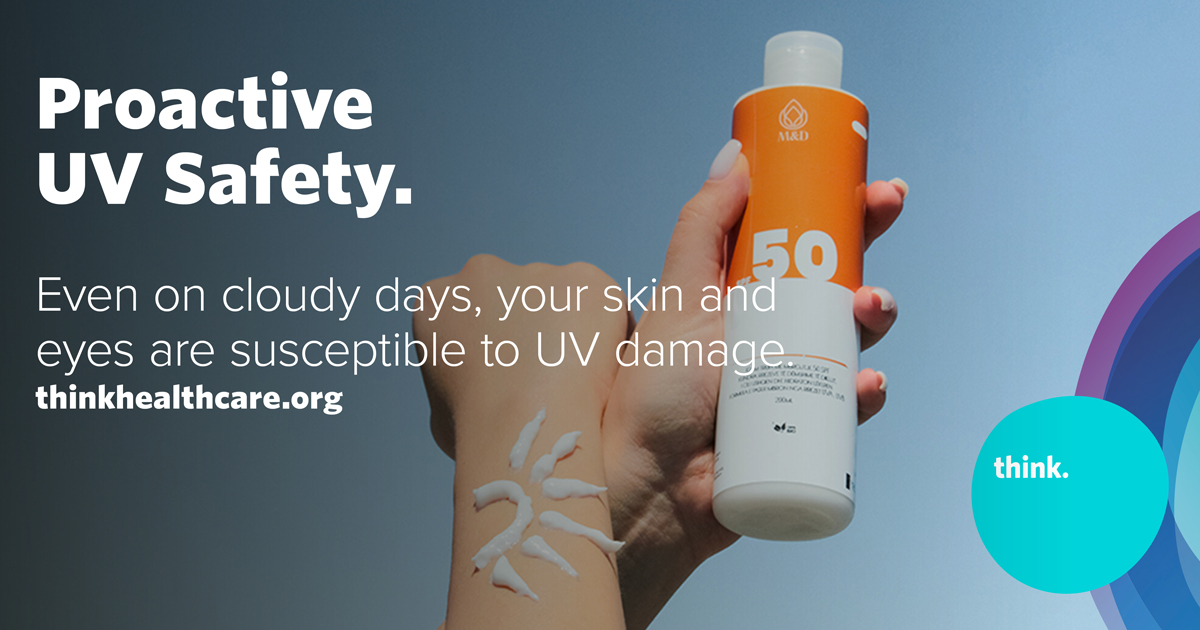While summer is naturally the time to soak up extra sun, it is also the season for protecting yourself from harmful ultraviolet (UV) radiation. UV rays are strongest in spring and summer, and at higher elevations, more UV rays reach the ground.
Even on cloudy days, your skin and eyes are susceptible to UV damage. UV radiation is the leading cause of skin cancer and can affect eyesight including blurry or spotty vision, cataracts, macular degeneration and other forms of vision loss. Overexposure to UV radiation can also weaken the immune system, intensify sunspots and wrinkles and speed up premature aging.
The American Academy of Dermatology Association (AAD) reports that an estimated 9,500 people in the United States are diagnosed with skin cancer every day. Currently, more than 1 million Americans are living with melanoma, the deadliest kind of skin cancer. To help lower these incident rates, the AAD launches its annual skin cancer awareness program followed in July by UV Awareness Month.
Who Is at Highest Risk?
Anyone, regardless of age, can face harmful health effects from UV radiation. Risks of sun damage increase for people who:
- Remain outside in the sun more frequently or use indoor beds or sunlamps.
- Experience a history of sunburns.
- Are fair skinned with light hair and eyes.
- Have a personal or family member history of skin cancer.
- Live or vacation at high altitudes or tropical/subtropical climates.
- Are over age 50 or are young children, especially under 6 months old.
- Take certain oral or topical medications that make the skin sensitive to light. These include antibiotics, birth control pills and benzoyl peroxide products.
- Take medications that lower or suppress the immune system.
Protection From UV Radiation
Overexposure to UV light is preventable. The following are steps you can take to protect your skin and eyes from UV radiation damage.
• Apply a broad-spectrum, water-resistant sunscreen with a Sun Protection Factor (SPF) of 30 or higher to all exposed skin. Be sure to check the expiration date on the sunscreen. Sunscreen is usually good for two to three years. Reapply sunscreen after swimming or sweating and about every two hours in the sun. Also use a lip balm to protect your lips. Note that sunscreen does not fully block all sun rays. Use sunscreen generously in addition to taking other protection precautions.
• Limit time spent in direct sun, especially when the sun rays are most intense, usually from 10 a.m. to 4 p.m. Stay in the shade as much as possible.
• Wear protective clothing outside including long sleeves and a broad-brimmed hat that shades the face, nose, forehead, scalp, neck and ears. Some clothing is designed with UV protection.
• Wear polarized sunglasses that wrap around to protect eyes from every angle and block 99-100% of UV rays. Children need to wear smaller-sized adult protective sunglasses and not toy sunglasses.
• Do not use tanning beds, sun lamps or welding lamps, which also emit UV radiation.
• Be cautious around the intense sunlight that reflects off water, snow, sand and cement.
• Check your skin regularly for any changes and see a dermatologist about any parts of your skin that bleed or have changed color or size. During periodic health exams, also ask your doctor for a skin cancer check.
Using the UV Index
The U.S. National Weather Service and the Environmental Protection Agency (EPA) have developed the UV Index to help pinpoint the strength of UV light in areas of the country, on a scale of 1 to 11. A higher number indicates greater risk of sunburn and skin damage. Many weather forecasts nationwide include the UV Index. To check the UV Index forecast in your location and learn more about the index overall, visit the EPA’s website at www.epa.gov/sunsafety/uv-index-1.
LEARN MORE ABOUT UV RADIATION PROTECTION BY SPEAKING WITH YOUR PRIMARY CARE PROVIDER
Think makes it easy to receive both preventative care and treatment for your skin and eyes, especially if affected by sun exposure. From blistered sunburns to cataracts, our wide range of primary care providers and specialists are here for you on sunny and cloudy days and everything in between.
Our walk-in clinic treats anyone, even those who are not a think patient or do not have a primary care provider currently. To learn more about our wide-ranging healthcare services, visit our Services page online and choose your own think medical professionals by visiting our Meet Your Doctor page.
